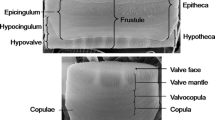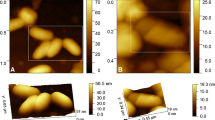Abstract
The atomic force microscopy (AFM) is a recently developed, bench-top instrument that can image the surface structures of biological specimens at high resolution with simultaneous measurement of their size. This paper describes the application of AFM to marine bacteria. Both natural and cultured bacteria were retained on a filter or placed on glass, washed, air-dried and observed by AFM. The instrumental condition, the choice of suitable filter, effect of fixation and filtration, comparison with epifluorescent microscopic (EFM) count, and the size and shape of bacterial cells were investigated. An Isopore filter was best for concentration and subsequent observation because of its surface flatness. Cross section images showed that both rod and coccoid cells were flattened, the former usually having a two-humped shape. Bacterial cells were differentiated from non-living particles based on their cross section shape and size. Bacterial counts by AFM and EFM showed good agreement. Although size measurement is easily done by the instrument, AFM tends to overestimate the size of microspheres. More work is thus needed on the size measurement of living organisms. Because AFM easily provides images of natural bacterial cells at high magnification, it can be used as a new tool to study the fine structures of marine bacteria.
Similar content being viewed by others
References
Amro, N. A., L. P. Kotra, K. Wadu-Mesthrige, A. Bulychev, S. Mobashery and G. Liu (2000): High-resolution atomic force microscopy studies of the Escherichia coliouter membrane: structural basis for permeability. Langmuir, 16, 2789–2796.
Binnig, G., C. F. Quate and C. Gerber (1986): Atomic force microscope. Phys. Rev. Lett., 56, 930–933.
Bjørnsen, P. K. (1986): Automatic determination of bacterioplankton biomass by image analysis. Appl. Environ. Microbiol., 51, 1199–1204.
Bolshakova, A. V., O. I. Kiselyova, A. S. Filonov, O. Y. Frolova, Y. L. Lyubchenko and Y. IV. Bolshakova (2001): Comparative studies of bacteria with an atomic force microscopy operating in different modes. Ultramicroscopy, 86, 121–128.
Braga, P. C. and D. Ricci (1998): Atomic force microscopy: application to investigation of Escherichia colimorphology before and after exposure to cefodizime. Antimicrob. Agents Chemother., 42, 18–22.
Bratbak, G. (1985): Bacterial biovolume and biomass estimations. Appl. Environ. Microbiol., 49, 1488–1493.
Dufrêne, Y. F. (2002): Atomic force microscopy, a powerful tool in microbiology. J. Bacteriol., 184, 5205–5213.
Fagerbakke, K. M., M. Heldal and S. Norland (1996): Content of carbon, nitrogen, oxygen, sulfur and phosphorus in native aquatic and cultured bacteria. Aquat. Microb. Ecol., 10, 15–27.
Fukuda, H. and I. Koike (2000): Feeding currents of particleattached nanoflagellates-A novel mechanism for aggregation of submicron particles. Mar. Ecol. Prog. Ser., 202, 101–112.
Koike, I., S. Hara, K. Terauchi and K. Kogure (1990): Role of sub-micrometre particles in the ocean. Nature, 345, 242–244.
Lee, S. and J. A. Fuhrman (1987): Relationships between biovolume and biomass of naturally derived marine bacterioplankton. Appl. Environ. Microbiol., 53, 1298–1303.
Loferer-Krößbacher, M., J. Klima and R. Psenner (1998): Determination of bacterial cell dry mass by transmission electron microscopy and densitometric image analysis. Appl. Environ. Microbiol., 64, 688–694.
Nagata, T. (1986): Carbon and nitrogen content of natural planktonic bacteria. Appl. Environ. Microbiol., 52, 28–32.
Nagata, T. and Y. Watanabe (1990): Carbon-and nitrogen-tovolume ratios of bacterioplankton grown under different nutritional conditions. Appl. Environ. Microbiol., 56, 1303–1309.
Neidhardt, F. C. and H. E. Umbarger (1996): Chemical composition of Escherichia coli. p. 13–16. In Escherichia coli and Salmonella, ed. by F. C. Neidhardt, ASM Press, Washington, D.C.
Porter, K. G. and Y. S. Feig (1980): The use of DAPI for identifying and counting aquatic microflora. Limnol. Oceanogr., 25, 943–948.
Psenner, R. (1990): From image analysis to chemical analysis of bacteria: A long-term study? Limnol. Oceanogr., 35, 234–237.
Ramirez-Aguilar, K. A. and K. L. Rowlen (1998): Tip characterization from AFM images of nanometric spherical particles. Langmuir, 14, 2562–2566.
Sieburth, J. M. (1975): Microbial Seascapes. University Park Press, Baltimore, U.S.A.
Simon, M. and F. Azam (1989): Protein content and protein synthesis rates of planktonic marine bacteria. Mar. Ecol. Prog. Ser., 51, 201–213.
Umeda, A., M. Saito and K. Amako (1998): Surface characteristics of Gram-negative and Gram-positive bacteria in an atomic force microscope image. Microbiol. Immunol., 42, 159–164.
Viles, C. L. and M. E. Sieracki (1992): Measurement of marine picoplankton cell size by using a cooled, charge-coupled device camera with image-analyzed fluorescence microscopy. Appl. Environ. Microbiol., 58, 584–592.
Woldringh, C. L., M. A. DeJong, W. V. D. Berg and L. Koppes (1977): Morphological analysis of the division cycle of two Escherichia colisubstrains during slow growth. J. Bacteriol., 131, 270–279.
Author information
Authors and Affiliations
Rights and permissions
About this article
Cite this article
Nishino, T., Ikemoto, E. & Kogure, K. Application of Atomic Force Microscopy to Observation of Marine Bacteria. Journal of Oceanography 60, 219–225 (2004). https://doi.org/10.1023/B:JOCE.0000038328.54339.e4
Issue Date:
DOI: https://doi.org/10.1023/B:JOCE.0000038328.54339.e4




